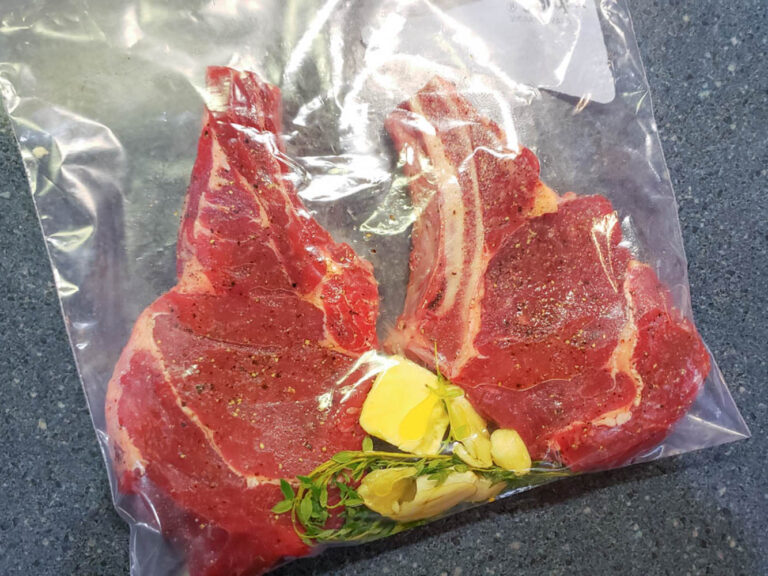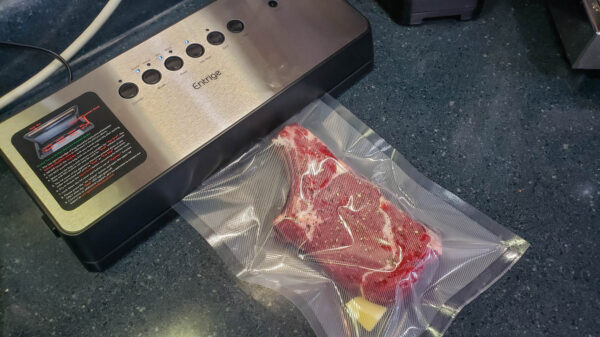Disclaimers: Our site uses demographic data, email opt-ins, display advertising, and affiliate links. Please check out our Terms and Conditions for more information.
For water bath cooking with sous vide, you cannot, obviously, just put your food straight into the water unprotected. It must be placed into the water via a water-tight container, and popular options include freezer bags, vacuum bags, and even glass canning jars to name a few.
While each one of these has merit for its own unique reasons, odds are good you'll see recipes that recommend using zipper freezer bags or vacuum bags most often.
But what is the difference between the two? We wanted to it down a bit more in this one, as once we switched to using vacuum bags we never looked back!
Freezer Bag Pros and Cons
Freezer bags are often the go-to for new sous vide users for one simple reason- you likely already have them in your kitchen.
Freezer bags are made with thick plastic and a robust zipper that can hold up to many sous vide operating conditions. All you have to do is put your food in the freezer bags, use the water displacement method to seal it, ensure the bag does not float, and you are good to go without having to buy any extra products.
Some of the best uses of freezer bags include when you cook more delicate food items in sous vide (meatballs are a favorite of ours) as well as when the ingredients are a bit more liquidy. Vacuum sealers may compress your food slightly, so delicate items are not recommended, and of course ingredients beyond a little bit of liquid are highly discouraged as well.
There are some pitfalls to using freezer bags; however, as they sometimes have micro holes that can grow over time (we notice this with long cooks often greater than 24 hours) and the zipper can sometimes become less effective at warmer temperatures (the plastic itself is rated to about 190°F, but we've noticed leaks as we approach 175-180°F in shorter cook times). As such, freezer bags are best used for shorter cooks (roughly four hours) and lower temperatures (say, 140-150°F) as a quick rule of thumb.
As an extra precaution, we always try to orient our freezer bags such that the zipper is always outside of the water bath. This is best accomplished with a dedicated sous vide vessel with lid (always check compatibility) where you can pinch some of the zipper ends under the lid itself. Depending on your cook and how much it floats, this is sometimes easier said than done. But as the zipper is often a point of failure, it is good practice to us all the same.
- Note: It deserves a mention that we only recommend using freezer-rated bags as opposed to general sandwich bags. This is for a few reasons, specifically that the zipper tends to be a bit more heavy-duty (read: water-tight) and the plastic tends to be thicker and can withstand the heat of the water bath. Always go for freezer-rated bags when using this option and be careful of the issues we outlined above.
Vacuum Sealer Pros and Cons
Vacuum sealers fix a lot of the general concerns noted above with freezer bags as, when sealed, odds are low that you'd have any place in the bag that is more likely to fail over others (read: heat-sealed edges and no zipper).
If you are unaware of how these machines work, they perform two core functions- they suck air out of a bag and then, while the vacuum is being held, apply heat to melt the plastic and form a seal. Easy!
Apart from function, we've found that vacuum bags tend to be just a bit cheaper than freezer bags overall. While the savings may not offset the price of the machine in any appreciable time (they typically run $40-$100 whereas the price difference may be under a dollar per dozen bags), if you've ever wanted one for other reasons using it for sous vide may be what pushes you over the edge to justify the purchase- that was our case exactly.
That being said, we do have to admit that vacuum bags are excellent at getting far more air out of bags than the water displacement method and help minimize the floating problem just a bit more as well. However, when sealing vacuum bags you also have to err on the drier side of ingredients which could influence how you make some recipes (for wetter cooks, freezer bags or even ball jars may be a better alternative).
Overall, when in doubt you can always stick to the freezer bag route, and if you see some of the issues we noted above you may want to consider upgrading to the vacuum bag process instead if you can justify the cost. We did, and we do not look back!
Do you use freezer bags or vacuum bags with sous vide? Comment below to share why!
Read More About Sous Vide
Want to learn more about sous vide cooking? Check out some of our top posts:






